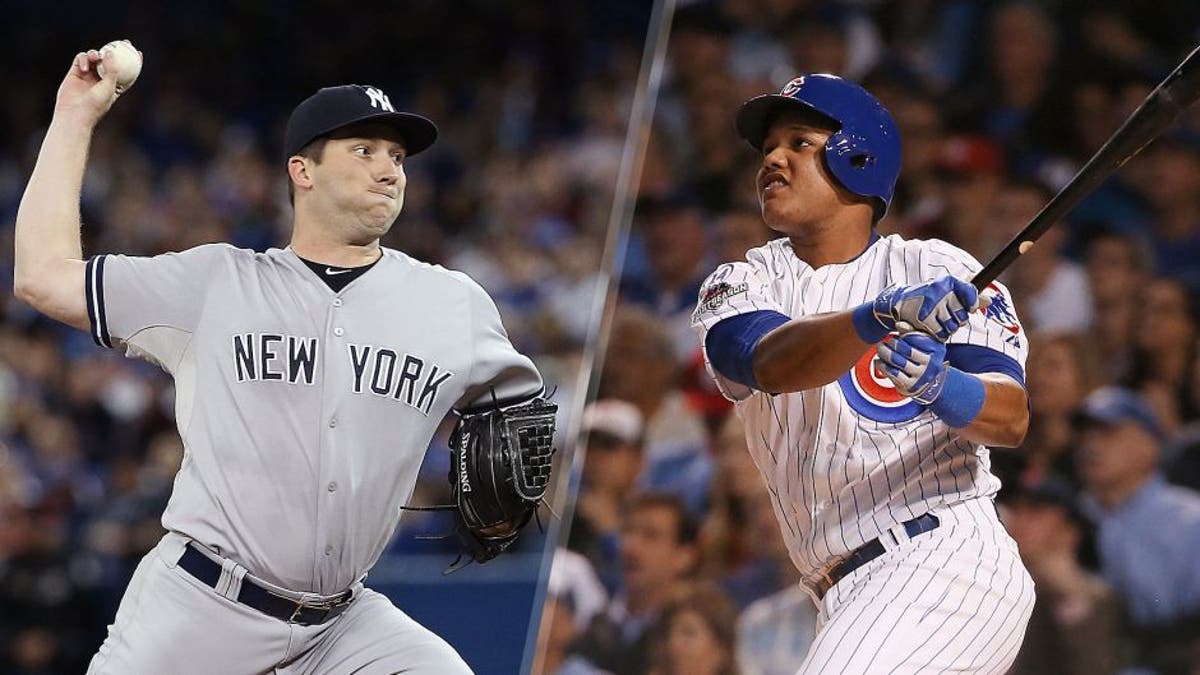
Adam Warren #43 of the New York Yankees delivers a pitch in the third inning during MLB game action against the Toronto Blue Jays on September 21, 2015 at Rogers Centre in Toronto, Ontario, Canada. (Photo by Tom Szczerbowski/Getty Images) Starlin Castro #13 of the Chicago Cubs hits a solo home run in the fourth inning against the St. Louis Cardinals during game three of the National League Division Series at Wrigley Field on October 12, 2015 in Chicago, Illinois. (Photo by Jonathan Daniel/Getty Images)
First thing's first: At this point, it's impossible to evaluate the trade that's turned Starlin Castro into a New York Yankee and Adam Warren into a Chicago Cub. For the simple reason that somebody else is becoming a Chicago Cub, but we don't know who yet.
Or maybe we can evaluate it! Maybe we can say it's a fair trade, because most trades are fair, or roughly fair, when they happen. Not to mention the fact that Theo Epstein and Brian Cashman are both rational actors.
What we can do is evaluate Starlin Castro and Adam Warren.
This is just about the farthest thing from a "challenge trade" -- like for like -- as Castro and Warren could hardly be more different.
One's a relief pitcher who occasionally starts, and one's a second baseman who can play shortstop. The relief pitcher is a really good bet to be pretty good in 2016, while the erstwhile shortstop ... well, that's the $64 Million Question, right? Among seemingly healthy players, is there a notable player in the majors who comes with more uncertainty than Starlin Castro?
Castro was an everyday player in the majors at 20. At 21 and 22, he was a really good everyday player in the majors. At 23 he was awful, at 24 he was really good again, and at 25 he was awful again.
It's worth mentioning that Castro hasn't turned 26, but is one decent week away from 1,000 career hits. Since World War II, only 31 players have collected more than 900 hits through their Age 25 season. More than half are in the Hall of Fame or will be, and most of the rest put together outstanding careers.
That said, we can't say with any real confidence that Castro hasn't peaked yet. If you believe these graphs, players typically plateau at approximately 23, and hold (roughly) steady for eight or nine years.
But that's just one study. Some decades ago, Bill James concluded that players most typically peaked at around 27, while J.C. Bradbury concluded just a few years ago that the correct number is actually 29 or 30.
So even after all these years and all the studies, there's somehow no real consensus on aging patterns, except that a player's probably going to be better at 25 than 35.
Gee, thanks fellas. And it seemed like such a simple question.
Getting back to where we started, while it's impossible to properly evaluate this trade, since the Yankees owe the Cubs another player, there's one thing we can confidently say: Castro's stock has fallen.
Yes, Warren's a pretty good relief pitcher. But if you shake a tree, a pretty good relief pitcher will fall out. And nobody knows this better than the Cubs. As Joe Sheehan pointed out in his newsletter,
Well, you know what I think. But while the Cubs have very few holes to fill, I suspect that if they could have gotten more than a pretty good relief pitcher for Castro, they would have. Since they're one of the last teams that would place a high value on a guy like Warren, who's manifestly useful but apparently fungible.
And the more I think about it, the more this looks like a salary dump, as Castro's still got more than $40 million guaranteed over the next five years (including a $1 million buyout in 2020). It seems the Cubs couldn't justify spending that sort of money on a player without a defined role in the coming seasons, and they couldn't find many teams bullish on Castro's future. Whatever the preferred aging curve.
The Yankees don't have a second baseman, and they can find another Adam Warren. So acquiring Castro is a perfectly reasonable move, just as trading Shane Greene for Didi Gregorius was a perfectly reasonable move. And if Castro works out as well as Gregorius, Brian Cashman will be ahead of the game.
